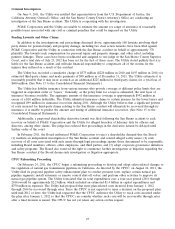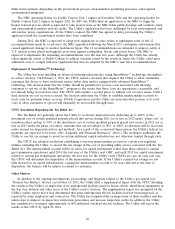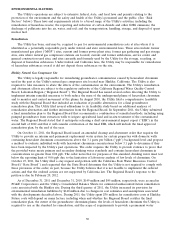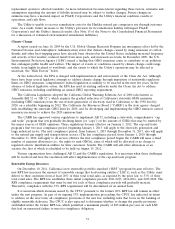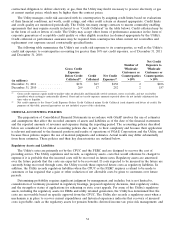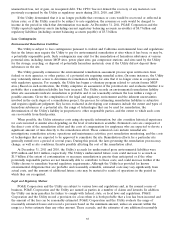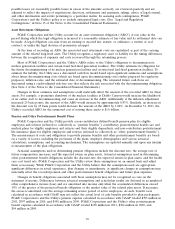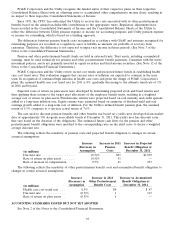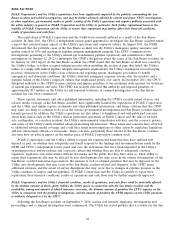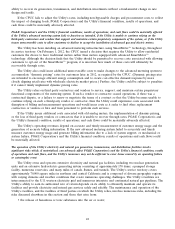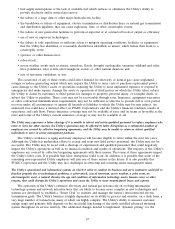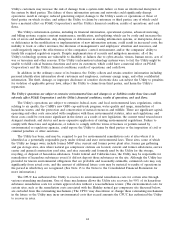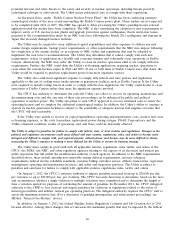PG&E 2011 Annual Report Download - page 40
Download and view the complete annual report
Please find page 40 of the 2011 PG&E annual report below. You can navigate through the pages in the report by either clicking on the pages listed below, or by using the keyword search tool below to find specific information within the annual report.possible losses (or reasonably possible losses in excess of the amounts accrued), are reviewed quarterly and are
adjusted to reflect the impacts of negotiations, discovery, settlements and payments, rulings, advice of legal counsel,
and other information and events pertaining to a particular matter. In assessing such contingencies, PG&E
Corporation’s and the Utility’s policy is to exclude anticipated legal costs. (See ‘‘Legal and Regulatory
Contingencies’’ in Note 15 of the Notes to the Consolidated Financial Statements.)
Asset Retirement Obligations
PG&E Corporation and the Utility account for an asset retirement obligation (‘‘ARO’’) at fair value in the
period during which the legal obligation is incurred if a reasonable estimate of fair value and its settlement date can
be made. A legal obligation can arise from an existing or enacted law, statute, or ordinance; a written or oral
contract; or under the legal doctrine of promissory estoppel.
At the time of recording an ARO, the associated asset retirement costs are capitalized as part of the carrying
amount of the related long-lived asset. The Utility recognizes a regulatory asset or liability for the timing differences
between the recognition of expenses and costs recovered through the ratemaking process.
Most of PG&E Corporation’s and the Utility’s AROs relate to the Utility’s obligation to decommission its
nuclear generation facilities and certain fossil fuel-fired generation facilities. The Utility estimates its obligation for
the future decommissioning of its nuclear generation facilities and certain fossil fuel-fired generation facilities. To
estimate the liability, the Utility uses a discounted cash flow model based upon significant estimates and assumptions
about future decommissioning costs (which are based upon decommissioning costs studies prepared for regulatory
purposes), inflation rates, and the estimated date of decommissioning. The estimated future cash flows are
discounted using a credit-adjusted risk-free rate that reflects the risk associated with the decommissioning obligation.
(See Note 2 of the Notes to the Consolidated Financial Statements.)
Changes in these estimates and assumptions could materially affect the amount of the recorded ARO for these
assets. For example, a premature shutdown of the nuclear facilities at Diablo Canyon would increase the likelihood
of an earlier start to decommissioning and cause an increase in the ARO. Additionally, if the inflation adjustment
increased 25 basis points, the amount of the ARO would increase by approximately 0.83%. Similarly, an increase in
the discount rate by 25 basis points would decrease the amount of the ARO by 1.02%. At December 31, 2011, the
Utility’s recorded ARO for the estimated cost of retiring these assets is $1.6 billion.
Pension and Other Postretirement Benefit Plans
PG&E Corporation and the Utility provide a non-contributory defined benefit pension plan for eligible
employees and retirees (referred to collectively as ‘‘pension benefits’’), contributory postretirement health care and
medical plans for eligible employees and retirees and their eligible dependents, and non-contributory postretirement
life insurance plans for eligible employees and retirees (referred to collectively as ‘‘other postretirement benefits’’).
The measurement of costs and obligations to provide pension benefits and other postretirement benefits are based
on a variety of factors, including the provisions of the plans, employee demographics and various actuarial
calculations, assumptions, and accounting mechanisms. The assumptions are updated annually and upon any interim
re-measurement of the plan obligations.
Actuarial assumptions used in determining pension obligations include the discount rate, the average rate of
future compensation increases, and the expected return on plan assets. Actuarial assumptions used in determining
other postretirement benefit obligations include the discount rate, the expected return on plan assets, and the health
care cost trend rate. PG&E Corporation and the Utility review these assumptions on an annual basis and adjust
them as necessary. While PG&E Corporation and the Utility believe that the assumptions used are appropriate,
significant differences in actual experience, plan changes or amendments, or significant changes in assumptions may
materially affect the recorded pension and other postretirement benefit obligations and future plan expenses.
Changes in benefit obligations associated with these assumptions may not be recognized as costs on the
statement of income. Differences between actuarial assumptions and actual plan results are deferred in accumulated
other comprehensive income (loss) and are amortized into income only when the accumulated differences exceed
10% of the greater of the projected benefit obligation or the market value of the related plan assets. If necessary,
the excess is amortized over the average remaining service period of active employees. As such, benefit costs
calculated in accordance with GAAP may not reflect the actual level of cash benefits provided to plan participants.
PG&E Corporation’s and the Utility’s pension expense calculated in accordance with GAAP totaled $395 million in
2011, $397 million in 2010, and $458 million in 2009. PG&E Corporation and the Utility’s other postretirement
benefit expense calculated in accordance with GAAP totaled $108 million in 2011, $104 million in 2010, and
$94 million in 2009.
36



